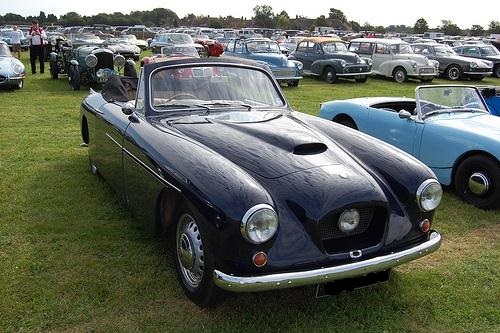-
Insurance
InsuranceAbout our productsLearn about insuringGet a quote Get current values, historical values, model history and more.
-
Valuation
ValuationHagerty valuation toolLook up a vehicle value Get current values, historical values, model history and more.
-
Events
EventsHagerty official eventsHagerty ClubhouseEvent calendar
-
Entertainment
EntertainmentMore to explore
- Shop
- Portal login
1957 Bristol 405
Base 4dr Saloon 2 L
Vehicle values by condition
Fair
Condition 4
£19,800
#4 cars are daily drivers, with flaws visible to the naked eye. The chrome might have pitting or scratches, the windshield might be chipped.
Good
Condition 3
£32,700
#3 cars could possess some, but not all of the issues of a #4 car, but they will be balanced by other factors such as a fresh paint job or a new, correct interior.
Excellent
Condition 2
£43,800
#2 cars could win a local or regional show. They can be former #1 cars that have been driven or have aged. Seasoned observers will have to look closely for flaws.
Concours
Condition 1
£66,300
#1 vehicles are the best in the world. The visual image is of the best car, unmodified, in the right colours, driving onto the lawn at the finest concours.
Insurance premium for a
1957 Bristol 405 Base 4dr Saloon 1971
valued at £32,700
£194.20
/ year*
History of the 1953 - 1958 Bristol 405

1953 - 1958 Bristol 405
The Brstol 405 range simultaneously represented progression and retrogression from its predecessor. The body was the first Bristol not to resemble the pre-war BMW 328, and the 405 was also the first Bristol to be offered as a four-door saloon, but Superleggera construction was replaced by a partially wooden body frame. As with the 403, the engine was a 2-litre I-6 OHV unit, with rack-and-pinion steering. The suspension was independent upper wishbones and transverse leaf spring with an anti-roll bar at the front and a live axle with longitudinal torsion bars at the rear.
Bristol debuted the 405 at the London Motor Show in October 1954. Standard fittings included overdrive, adjustable steering and door armrests and ‘one-shot’ chassis lubrication. It was also the first Bristol with flashing indicators and an opening boot lid, while other features included the soon to be familiar ‘seven dial’ dashboard and a spare wheel storage compartment in the nearside front wing. Optional extras included front disc brakes. The top speed was 110mph, and the price was a £3,188 12s 1d. The large glass area earned the 405 the nickname of ‘The Flying Greenhouse’ and one interesting detail was that the rear doors were bigger than those at the front.
Choices of coachwork were the saloon and a 405D drophead coupe made to order by Abbotts of Farnham. Only 51 405 dropheads were built in contrast to 294 four-doors. Bristol 405 production ceased in 1958, following the introduction of the 406 in the previous year.
Power was from the Bristol 1,971cc triple Solex carburettor engine in 100B2 guise, and the transmission was a 4-speed manual unit with a Laycock de Normanville overdrive, a freewheel on first gear and synchromesh on the top three ratios.
For the motorist who craved genuinely exclusive transport that blended the abilities of a sports car with coachbuilt fittings, the 405 was the ideal choice. It is one of those British luxury saloons of the 1950s upon which automatic transmission would be mostly wasted, as it demands to be piloted with enthusiasm.
As the 405’s construction is a steel chassis with wood and aluminium, it should be very carefully checked for any deterioration of the timber’s condition in addition to all points where the two different metals meet. Ahead of the A-pillar the 405 and the 404 (q.v.) are the same, but many of the former's parts are unique to that model.
The Bristol 405 was a lasting reminder of how the company created its own traditions rather than slavishly following those of other manufacturers. Its aerodynamic body with its idiosyncratic lines denote a car that requires to be appreciated entirely on its own term.
The 405’s competitors included the Jaguar Mk VIIM and Mk VIII, the Alvis ‘Grey Lady’ and the Lagonda 3-Litre.
Hagerty Newsletter
Get your weekly dose of car news from Hagerty UK in your inbox

ADVERTISEMENT